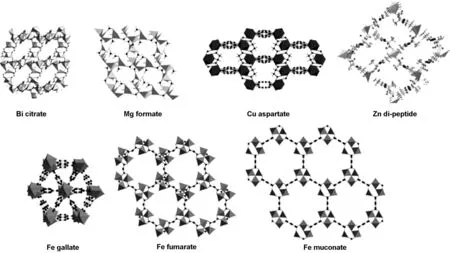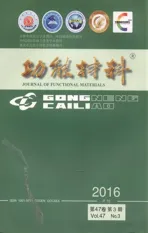金属-有机骨架用于各类药物的控释载体
2016-05-25马艾华胡庭维贾庆明陕绍云苏红莹王亚明
马艾华,胡庭维,贾庆明,陕绍云,苏红莹,王亚明
(昆明理工大学 化学工程学院,昆明 650500)
金属-有机骨架用于各类药物的控释载体
马艾华,胡庭维,贾庆明,陕绍云,苏红莹,王亚明
(昆明理工大学 化学工程学院,昆明 650500)
摘要:新型控释药物直接作用于靶细胞,提高药理效率、减小毒副作用,已成为一种极具潜力的药疗方法。与一般药物控释载体相比,金属-有机骨架材料(metal-organic frameworks,MOFs)的优势明显,将其颗粒尺寸降至纳米级后性能更为优异,能同时兼顾药物负载量、目标靶向性、表面特性改善和生物相容性等特性。目前,已有较多类药物吸附在MOFs上的研究报道,主要包括抗癌药物、抗病毒药物及消炎药物。介绍了MOFs的毒性及其发展过程,详细阐述了MOFs对于各类药物的吸附-释放情况,并对此领域的研究和发展进行总结和展望,以期对MOFs作为药物控释载体的应用有比较全面的认识。
关键词:金属-有机骨架;控释药物;生物毒性;抗癌抗病毒;消炎药物
0引言
将药物负载在适宜的载体上,可改善药物分子在人体内的释放、吸收、代谢和排泄过程,显著提高药物利用率,减弱高浓度药物的毒副作用[1]。科研人员已发现多种合成材料均可用作控释载体,主要有分子筛、胶束、脂质体、树状聚合物等[2-5],但此类物质在药物负载量、目标靶向性、药物释放动力学、表面特性改善和生物相容性等方面并不能同时兼顾,均存在一定的缺陷。
近年来,金属-有机骨架(metal-organic frameworks,MOFs)在诸多领域的应用研究发展迅速,主要归因于其内部规整、比表面积大、结构可调,同时可根据客体分子的体积和性质改变内部特性[6-10]。此外,官能化修饰后的MOFs可同时实现高载药量和适宜的药物释放速率[11-12],且纳米级MOFs-药物控释剂颗粒的合成简单、稳定性好、靶向性强。现阶段对于改善MOFs生物相容性的研究也取得较大进展,已成为近年研究比较热门的一类新型药物控释材料[13-16]。
1MOFs材料特性
1.1MOFs的生物毒性
药物控释材料的生物相容性研究主要是为了改善药物-载体在生物体内的毒性,避免其对细胞和组织的毒害作用。
目前,对于MOFs生物毒性的研究主要侧重于增强MOF整体稳定性、降低金属中心的毒性和有机配体的毒性3个方面。研究人员选用生物体必需的金属元素铁、钙、镁、锌和锆等作为MOFs的金属中心[11, 15-16],但这类金属的摄入量仍需控制在安全范围内[15]。对于有机配体,内源性配体是生物体新陈代谢的中间物质,生物相容性好,已应用于MOFs制备的主要有烟酸、延胡索酸、黄嘌呤、氨基酸等[17-22]。对于MOFs的配体毒性研究,亲水-疏水平衡也是重要参数之一,研究证明含有亲水基团的MOFs细胞毒性相对较小[23]。
此外,Patricia Horcajada小组[15, 21]进一步研究了Fe-MOFs在小鼠体内循环分布代谢的情况见图1。MOFs注入小鼠体内后没有出现明显的脑中毒现象,只在肝脏和肾脏中短暂积累,随后被迅速排出体外,组织器官并没有持续中毒的迹象。
1.2MOFs的结构特性
用于药物负载时,MOFs材料的结构优异性体现在孔道结构和骨架结构两方面。就孔道结构而言,有些MOFs(如MIL-53)的孔道可随环境温度和压力的变化而改变,从而产生呼吸效应[24];有些MOFs(MIL-100(Fe))则拥有两种不同尺寸的介孔[25];还有一些MOFs(UMCM-1)同时具有尺寸为1.4 nm×1.7 nm的微孔和2.7 nm×3.2 nm的介孔[26]。MOFs内部孔道结构灵活多变、尺寸范围较广,能为多种药物分子提供可靠的吸附存储空间。在骨架结构方面,通过选用不同的金属中心和有机配体可以得到不同结构的MOFs[15](图2),也可改善药物-MOFs复合物颗粒的药理毒性[23-24, 27]。
1.3MOFs-药物的合成
载体颗粒尺寸大小影响着药物的吸附量及其疗效,纳米级药物-载体更容易进入目标细胞进行靶向性治疗[1, 28-30]。NMOFs制备方法较多,主要有溶剂/水热法、反相微乳液法、超声法和微波法,对MOFs结构形貌的影响也不尽相同[15, 31-35]。微波辅助水热法加热能量分布均匀、反应速度较快、易于操作,产率高,可得到各种尺寸的生物NMOFs,因此最为理想。

图1 药物-MOFs(Fe)的装载、运输、释放和分解代谢过程

图2 不同金属不同配体构成的MOFs结构[15]
Joaquín Coronas等[19]报道了一步法合成的咖啡因-ZIF-8复合颗粒,其检测性能甚至优于常规方法所得的目标产物。将负载后NMOFs的表面包裹1层球壳[32, 36-37]并将靶向性配体(RGD肽链)嫁接在球壳表面,随后,使具有靶向性的复合物进入细胞内部进行控释(图3)[32, 38-39]。当药物-NMOFs在细胞内部通常采用药物扩散、MOFs水解、光催化和pH值变化等方法来控制药物分子的缓释[15, 40-42]。
2抗癌药物
用于癌症化疗的药物较多,主要有金属杂类的顺铂、烷化剂类白消安、抗代谢类的5-氟脲嘧啶、抗生素类的阿霉素、黄胆素,植物类的喜树碱、长春碱等。
顺铂化合物具有广谱抗癌性,作用强而持久,在临床上运用广泛[33]。对比使用一步法制备的NCP-1[32]和用常规方法得到的ESCP-MIL-101(Fe)复合物(ESCP为乙氧基琥珀酸顺铂)[43],两者具有相似的控释效果和癌细胞毒性[36]。Wenbin Lin等[12]用UiO-NMOFs(Zn)同时吸附小干扰RNA(siRNAs) 和顺铂前驱体药物(图4)。结果表明,siRNAs/UiO-Cis的协同药效比普通疗法药效高出一个数量级。
Elsa Quartapelle Procopio[44]用镍做金属中心制备了一种可以吸附控释RAPTA-C(Ru(p-cymene)Cl2(pta))(pta=1,3,5-triaza-7-phospha-adamantane)的MOFs材料,该材料化学稳定性和热稳定性好、强度高,且对RAPTA-C的吸附量为1.1 g/g MOF。

图3 NCP-1合成后用PVP与正硅酸乙酯(TEOS)包裹,再在表面加上c(RGDfK)提高靶向性

图4 siRNA/UiO-Cis的制备与药物负载[12]
杨宝春等[45]使用MOF-5分别负载5-氟尿嘧啶(5-fluouourail,5-Fu)与辣椒素(capsaicin),由于药物分子中的酚羟基与MOF-5中的羧基存在相互作用,两者最高载药量分别为0.315 g/g MOF和0.592 g/g MOF。两种药物均在第7 d达到平衡且体外释药均有明显的两相模式,这表明MOF-5的表面和孔隙内部均可以吸附药物。
白消安(Busulfan)、 阿霉素(doxorubicin,DOXO)和喜树碱(Camptothecin,CPT)几种药物的毒副作用大,将其负载在纳米载体上可提高药物利用率,降低给药过程对身体的伤害。白消安具有亲水和疏水两种特性[11, 31],因此使用具有两亲结构的MIL-100(Fe)负载,最高吸附量可达26%(质量分数)[46]。用Zn-MOF负载阿霉素,其中的Zn2+可与阿霉素螯合形成醌和酚醛结构,阻止其对心肌的毒害[47-48]。Patricia Horcajada等[11]用纳米MIL-100对DOXO进行吸附,吸附量为9%(质量分数),且脱附效果较好,可在两周内逐步完全释放。Jia Zhuang等[49]将CPT负载在纳米ZIF-8上并利用细胞内部偏酸性的特性调节药物分子的释放。将拓扑替康(topotecan,TPT,喜树碱衍生物)负载在纳米MIL-100材料上,其最大负载量可达33%(质量分数),随后利用光辐射引发TPT释放,该过程对TPT分子结构没有影响[41]。
3抗病毒药物
叠氮胸苷三磷酸盐(azidothymidine triphosphate,AZT-TP)是一种抗HIV病毒感染的亲水性药物。但由于AZT-TP的细胞摄取量低且稳定性差限制了它的应用。近年来,大量用于吸附AZT-TP的材料涌现,如磁性纳米颗粒的吸附量为3.5%(质量分数);阳离子纳米凝胶的吸附量为30.0%(质量分数)[50];而MIL-100(Fe)-NH2的吸附量则可高达42.0%(质量分数)[11]。
Valentina Agostoni等[25, 51]使用MIL-100(Fe)吸附AZT-TP的最大量为24%(质量分数)。随后,该小组又深入考察了HF对MIL-100(Fe)吸附性能的影响,研究表明无氟情况下制备的MIL-100(Fe)吸附量较高为(24.3±4.4)%(质量分数),且吸附量与氟原子、骨架中残余的BTC无关,由于AZT-TP的磷酸基和不饱和Lewis酸性位点之间存在相互作用,均需48 h完全释放[53-54]。
4消炎药物
布洛芬(ibuprofen)具有抗炎、镇痛、解热的作用,但需频繁给药,长期进药会导致体内药物残留浓度过高,对人体产生毒副作用。将布洛芬吸附在特定载体上于体内指定部位释放可提高药效,从而减少药物对人体的伤害。2006年,Gérard Férey等[55]制备的MIL-100和MIL-101开启了MOFs用于药物载体的广泛研究。该课题组[56]以Fe作金属中心制得具有呼吸效应的MIL-53,脱水后布洛芬吸附量为0.21 g/g MOF。李宗群等[57]用ZnO/C/SNTs复合物与布洛芬反应合成药物组装体Zn(IBU)2/C/SNTs且载药量为752 mg/g。Zn(IBU)2在前12 h里释放速率比较快之后变得缓慢,2 d后Zn(IBU)2的浓度基本不变。由—NH2和—Br修饰的UiO-66(Zr)对布洛芬的负载动力学进行考察可知,MOF载药量的增加使配体的旋转空间减小,此时位阻效应对配体的动力学存在影响[58]。

表1 MOFs吸附控释几类药物的情况
2014年,Tomažĉendak等[59]在四氢呋喃溶剂(THF)中用MIL-101(Fe)-NH2负载消炎痛(indomethacin)并发现THF与金属骨架之间存在氢键作用。在每个MOF单元中,MIL-101(Fe)-NH2的负载量为(2.2±0.3)个消炎痛分子。Fei Ke等[60]报道了一种由Cu3(BTC)2纳米晶体嵌入Fe3O4纳米棒上制成的MOF,每克该MOF可吸附0.2 g的尼美舒利(Nimesulide)。
5结语
MOFs结构和组成可调、孔隙比表面积大、易于功能化修饰,且金属位点较多,在药物控释载体的应用方面具有显著优势。选择适当的金属、配体,改变链接方式可赋予MOFs优异的生物性能,同时增强药物分子的吸附和控释效率,另外MOFs较好的晶体结构便于模型化研究其吸附脱附机理。到目前为止,在药物载体中MOFs的吸附量最大,释放控制也比较好[11, 31, 46, 48]。
现阶段,虽然MOFs作为药物载体的研究已取得一定的进步,但其在临床医学上的实际应用仍有大量挑战性工作亟需完成。首先,MOFs吸脱附动力学并不十分清晰;其次,MOFs生物毒性虽已得到改善,但运载、代谢排泄机制、生理穿透和慢性毒性等问题有待进一步探索,因此体内药物动力学研究将是以后MOFs生物医学应用的核心。此外,现在可生物应用的MOFs类别较少,对可负载药物种类有较大的限制,扩充生物MOFs及负载药物的种类,使其应用到更多疾病的治疗上。
目前,MOFs的医学应用尚处于早期发展阶段,其在药物载体上的应用潜力已得到肯定。充分发展MOFs的固有优势,解决体内控释吸收问题,MOFs在药物方面的应用前景将会更加广阔。
参考文献:
[1]Davis M E, Shin D M. Nanoparticle therapeutics: an emerging treatment modality for cancer [J]. Nature Reviews Drug Discovery, 2008, 7(9): 771-782.
[2]Cho K, Wang X, Nie S, et al. Therapeutic nanoparticles for drug delivery in cancer [J]. Clinical Cancer Research, 2008, 14(5): 1310-1316.
[3]Deng K, Hou Z, Li X, et al. Aptamer-mediated up-conversion core/MOF shell nanocomposites for targeted drug delivery and cell imaging [J]. Scientific Reports, 2015, 5:7851.
[4]Reimer N, Reinsch H, Inge A K, et al. New Al-MOFs based on sulfonyldibenzoate ions: a rare example of intralayer porosity [J]. Inorganic Chemistry, 2015, 54(2): 492-501.
[5]Alexis F, Pridgen E, Molnar L K, et al. Factors affecting the clearance and biodistribution of polymeric nanoparticles [J]. Molecular Pharmaceutics, 2008, 5(4): 505-515.
[6]Li H, Eddaoudi M, O’keeffe M, et al. Design and synthesis of an exceptionally stable and highly porous metal-organic framework [J]. Nature, 1999, 402(6759): 276-279.
[7]Mu Cuizhi, Xu Feng, Lei Wei. Application of functional metal-organic framework materials [J]. Progress in Chemistry, 2007, 19(9): 1345-1356.
穆翠枝, 徐峰, 雷威. 功能金属-有机骨架材料的应用[J]. 化学进展, 2007, 19(9): 1345-1356.
[8]Kuppler R J, Timmons D J, Fang Q R, et al. Potential applications of metal-organic frameworks [J]. Coordination Chemistry Reviews, 2009, 253(23): 3042-3066.
[9]Evans J D, Sumby C J, Doonan C J. Post-synthetic metalation of metal-organic frameworks [J]. Chemical Society Reviews, 2014, 43(16): 5933-5951.
[10]Song Xiaokai, ZhouYajing, Li Liang. Synthesis of core-shell metal-organic frameworks [J]. Progress in Chemistry, 2014, 26(2/3): 424-435.
宋肖锴, 周雅静, 李亮. 核壳结构金属-有机骨架的研究 [J]. 化学进展, 2014, 26(2/3): 424-435.
[11]Horcajada P, Chalati T, Serre C, et al. Porous metal-organic-framework nanoscale carriers as a potential platform for drug delivery and imaging [J]. Nature Materials, 2010, 9(2): 172-178.
[12]He C, Lu K, Liu D, et al. Nanoscale metal-organic frameworks for the co-delivery of cisplatin and pooled siRNAs to enhance therapeutic efficacy in drug-resistant ovarian cancer cells [J]. Journal of the American Chemical Society, 2014, 136(14): 5181-5184.
[13]Mckinlay A C, Morris R E, Horcajada P, et al. BioMOFs: metal-organic frameworks for biological and medical applications [J]. Angewandte Chemie International Edition, 2010, 49(36): 6260-6266.
[14]Huxford R C, Della Rocca J, Lin W. Metal-organic frameworks as potential drug carriers [J]. Current Opinion in Chemical Biology, 2010, 14(2): 262-268.
[15]Horcajada P, Gref R, Baati T, et al. Metal-organic frameworks in biomedicine [J]. Chemical Reviews, 2012, 112(2): 1232-1268.
[16]Keskin S, Kzlel S. Biomedical applications of metal organic frameworks [J]. Industrial & Engineering Chemistry Research, 2011, 50(4): 1799-1812.
[17]Imaz I, Rubio-Martínez M, Saletra W J, et al. Amino acid based metal-organic nanofibers [J]. Journal of the American Chemical Society, 2009, 131(51): 18222-18223.
[18]Rabone J, Yue Y F, Chong S, et al. An adaptable peptide-based porous material [J]. Science, 2010, 329(5995): 1053-1057.
[19]Liedana N, Galve A, Rubio C, et al. CAF@ZIF-8: one-step encapsulation of caffeine in MOF [J]. ACS Applied Materials Interfaces, 2012, 4(9): 5016-5021.
[20]Imaz I, Rubio-Martinez M, An J, et al. Metal-biomolecule frameworks (MBioFs) [J]. Chemical Communications, 2011, 47(26): 7287-7302.
[21]Baati T, Njim L, Neffati F, et al. In depth analysis of the in vivo toxicity of nanoparticles of porous iron(Ⅲ) metal-organic frameworks [J]. Chemical Science, 2013, 4(4): 1597-1607.
[22]Miller S R, Heurtaux D, Baati T, et al. Biodegradable therapeutic MOFs for the delivery of bioactive molecules [J]. Chemical Communications, 2010, 46(25): 4526-4528.
[23]Tamames-Tabar C, Cunha D, Imbuluzqueta E, et al. Cytotoxicity of nanoscaled metal-organic frameworks [J]. Journal of Materials Chemistry B, 2014, 2(3): 262.
[24]Devic T, Horcajada P, Serre C, et al. Functionalization in flexible porous solids: effects on the pore opening and the host-guest interactions [J]. Journal of the American Chemical Society, 2009, 132(3): 1127-1136.
[25]Agostoni V, Chalati T, Horcajada P, et al. Towards an improved anti-HIV activity of NRTI via metal-organic frameworks nanoparticles [J]. Advanced Healthcare Materials, 2013, 2(12): 1630-1637.
[26]Babarao R, Jiang J. Unraveling the energetics and dynamics of ibuprofen in mesoporous metal-organic frameworks [J]. Journal of Physical Chemistry C, 2009, 113(42): 18287-18291.
[27]Gaudin C, Cunha D, Ivanoff E, et al. A quantitative structure activity relationship approach to probe the influence of the functionalization on the drug encapsulation of porous metal-organic frameworks [J]. Microporous and Mesoporous Materials, 2012, 157:124-130.
[28]Petros R A, Desimone J M. Strategies in the design of nanoparticles for therapeutic applications [J]. Nature Reviews Drug Discovery, 2010, 9(8): 615-627.
[29]Xie J, Lee S, Chen X. Nanoparticle-based theranostic agents [J]. Advanced Drug Delivery Reviews, 2010, 62(11): 1064-1079.
[30]Taylor-Pashow K M, Rocca J D, Xie Z, et al. Postsynthetic modifications of iron-carboxylate nanoscale metal-organic frameworks for imaging and drug delivery [J]. Journal of the American Chemical Society, 2009, 131(40):14261-14263.
[31]Chalati T, Horcajada P, Gref R, et al. Optimisation of the synthesis of MOF nanoparticles made of flexible porous iron fumarate MIL-88A [J]. Journal of Materials Chemistry, 2011, 21(7): 2220-2227.
[32]Rieter W J, Pott K M, Taylor K M, et al. Nanoscale coordination polymers for platinum-based anticancer drug delivery [J]. Journal of the American Chemical Society, 2008, 130(35): 11584-11585.
[33]Taylor-Pashow K M L, Della Rocca J, Xie Z, et al. Postsynthetic modifications of iron-carboxylate hanoscale meter-organic frameworks for imaging and drug delivery[J]. Journal of the American Chemical Society, 2009,131(40):14261-14263.
[34]Rieter W J, Taylor K M L, An H, et al. Nanoscale metal-organic frameworks as potential multimodal contrast enhancing agents [J]. Journal of the American Chemical Society, 2006, 128(28): 9024-9025.
[35]Qiu L G, Li Z Q, Wu Y, et al. Facile synthesis of nanocrystals of a microporous metal-organic framework by an ultrasonic method and selective sensing of organoamines [J]. Chemical Communications, 2008, 31: 3642.
[36]Della Rocca J, Liu D, Lin W. Nanoscale metal-organic frameworks for biomedical imaging and drug delivery [J]. Accounts of Chemical Research, 2011, 44(10): 957-968.
[37]Rieter W J, Taylor K M, Lin W. Surface modification and functionalization of nanoscale metal-organic frameworks for controlled release and luminescence sensing [J]. Journal of the American Chemical Society, 2007, 129(32): 9852-9853.
[38]Taylor K M, Rieter W J, Lin W. Manganese-based nanoscale metal-organic frameworks for magnetic resonance imaging [J]. Journal of the American Chemical Society, 2008, 130(44): 14358-14359.
[39]Alhaddad A, Adam M P, Botsoa J, et al. Nanodiamond as a vector for siRNA delivery to ewing sarcoma cells [J]. Small, 2011, 7(21): 3087-3095.
[40]Sortino S. Photoactivated nanomaterials for biomedical release applications [J]. Journal of Materials Chemistry, 2012, 22(2): 301.
[41]Rosaria Di Nunzio M, Agostoni V, Cohen B, et al. A “Ship in a Bottle” strategy to load a hydrophilic anticancer drug in porous metal organic framework nanoparticles: efficient encapsulation, matrix stabilization, and photodelivery [J]. Journal of Medicinal Chemistry, 2014, 57(2): 411-420.
[42]Zhuang J, Kuo C H, Chou L Y, et al. Optimized metal-organic-framework nanospheres for drug delivery: evaluation of small-molecule encapsulation [J]. Acs Nano, 2014, 8(3): 2812-2819.
[43]Layre A, Couvreur P, Chacun H, et al. Novel composite core-shell nanoparticles as busulfan carriers [J]. Journal of Controlled Release, 2006, 111(3): 271-280.
[44]Procopio E Q, Rojas S, Padial N M, et al. Study of the incorporation and release of the non-conventional half-sandwich ruthenium(Ⅱ) metallodrug RAPTA-C on a robust MOF [J]. Chemical Communications, 2011, 47(42): 11751-11753.
[45]Yang Chunbao,Jiang Yaodong,Qin Xuejuanl,et al. Loaded and drug release of anticancer drugs in porous metal-organic frameworks [J]. Chemical Journal of Chinese Universities, 2012, 33 (1): 26-31.
杨宝春, 姜耀东, 秦雪娟,等. 抗肿瘤药物在金属有机骨架中的装载及体外释放 [J]. 高等学校化学学报, 2012, 33 (1): 26-31.
[46]Chalati T, Horcajada P, Couvreur P, et al. Porous metal organic framework nanoparticles to address the challenges related to busulfan encapsulation [J]. Nanomedicine, 2011, 6(10): 1683-1695.
[47]Vasconcelos I B, Silva T G D, Militão G C G, et al. Cytotoxicity and slow release of the anti-cancer drug doxorubicin from ZIF-8 [J]. RSC Advances, 2012, 25(2): 9437.
[48]Imaz I, Rubio-Martinez M, Garcia-Fernandez L, et al. Coordination polymer particles as potential drug delivery systems [J]. Chemical Communications, 2010, 46(26): 4737-4739.
[49]Zhuang J, Chun H, Chou L Y, et al. Optimized metal-organic framework nanospheres for drug delivery: evaluation of small-molecule encapsulation [J]. ACS Nano, 2013, 8(3): 2812-2819.
[50]Kabanov A V, Vinogradov S V. Nanogels as pharmaceutical carriers: finite networks of infinite capabilities [J]. Angewandte Chemie International Edition, 2009, 48(30): 5418-5429.
[51]Agostoni V, Anand R, Monti S, et al. Impact of phosphorylation on the encapsulation of nucleoside analogues within porous iron(Ⅲ) metal-organic framework MIL-100(Fe) nanoparticles [J]. Journal of Materials Chemistry B, 2013, 34(1): 4231.
[52]Agostoni V, Willaime H, Gref R, et al. “Green” fluorine-free mesoporous iron(Ⅲ) trimesate nanoparticles for drug delivery [J]. Green Materials, 2013, 1(4): 209-217.
[53]Hillaireau H, Couvreur P. Nanoencapsulation of antiviral nucleotide analogs [J]. Journal of Drug Delivery Science and Technology, 2009, 19(6): 385-390.
[54]Saiyed Z M, Gandhi N H, Nair M P N. AZT 5’-triphosphate nanoformulation suppresses human immunodeficiency virus type 1 replication in peripheral blood mononuclear cells [J]. Journal of Neurovirology, 2009, 15(4): 343-347.
[55]Horcajada P, Serre C, Vallet-Regí M, et al. Metal-organic frameworks as efficient materials for drug delivery [J]. Angewandte Chemie, 2006, 118(36): 6120-6124.
[56]Horcajada P, Serre C, Maurin G, et al. Flexible porous metal-organic frameworks for a controlled drug delivery [J]. Journal of the American Chemical Society, 2008, 130(21): 6774-6780.
[57]Li Zongjun,Ai Wang,Guo Chunyan. Synthesis of ZnO/C/SNTs and their drug using Zn-MOF as template delivery ability [J]. Chemical Journal of Chinese Universities, 2013, 34(11): 2470-2477.
李宗群, 艾汪, 郭春燕, 等. Zn-MOF模板法制备Zn/C/SNTs及其药物缓释性能 [J]. 高等学校化学学报, 2013, 34(11):2470-2477.
[58]Devautour-Vinot S, Diaby S, Da Cunha D, et al. Ligand dynamics of drug-loaded microporous zirconium terephthalates-based metal-organic frameworks: impact of the nature and concentration of the guest [J]. The Journal of Physical Chemistry C, 2014, 118(4): 1983-1989.

[60]Ke F, Yuan Y P, Qiu L G, et al. Facile fabrication of magnetic metal-organic framework nanocomposites for potential targeted drug delivery [J]. Journal of Materials Chemistry, 2011, 21(11): 3843-3848.
Metal-organic frameworks used as delivery vehicles for therapeutic agents
MA Aihua, HU Tingwei, JIA Qingming, SHAN Shaoyun, SU Hongying, WANG Yaming
(Faculty of Chemical Engineering,Kunming University of Science and Technology, Kunming 650500,China)
Abstract:Drug sustained delivery emerging as a class of therapeutics for the particular subsets of cells or tissues, that can show enhanced efficacy, while simultaneously reducing side effects, owing to properties such as less dose, more targeted localization in tumours and active cellular uptake. Metal-organic frameworks (MOFs) possess several potential advantages over conventional medicines, notabl they scaled down to nanometer sizes (NMOFs). MOFs have been used as promising drug carriers in biomedical applications due to the high drug loading capacity, intrinsic biodegradability, and versatile functionality. The bulk MOFs can absorb and release large amounts of therapeutic including anticancer and antiviral drugs and anti-inflammatory drugs. In this review, we outline the recent progress of using MOFs as delivery vehicles for therapeutic agents, demonstrate the continuous development and implementation in biomedical toxicology. Although signicant progress has been made in utilizing MOFs for drug delivery, further improvements must still occur before they can be considered for clinical therapeutics.
Key words:metal-organic frameworks;drug delivery;biomedical toxicology; anticancer and antiviral drugs;anti-inflammatory drugs
DOI:10.3969/j.issn.1001-9731.2016.03.007
文献标识码:A
中图分类号:O641.4; O647.3
作者简介:马艾华(1990-),女,吉林人,硕士,师承陕绍云教授,从事金属有机化合物研究。
基金项目:国家自然科学基金资助项目(51364023,21366014);后备人才项目资助项目(2015HB014)
文章编号:1001-9731(2016)03-03033-07
收到初稿日期:2015-05-07 收到修改稿日期:2015-09-10 通讯作者:陕绍云,E-mail: shansy411@163.com
